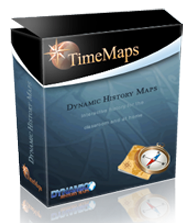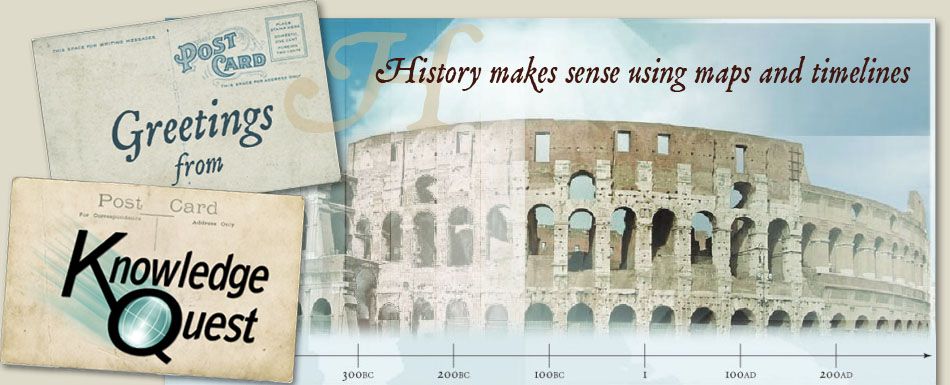As a student in the public school system, I don't remember doing much map work, other than all of the memory work for our 8th grade Geography class when we were required to memorize every country and capital, and to be able to pinpoint them on a map. I don't remember really learning much about the cultures of the countries, or their impact and influence on historical events...just memorizing and weekly quizzes. Doing nothing with maps but labeling them kind of takes all of the interesting out of using them, don't you think?
I am not implying that there is no value in being able to identify all of the fifty states and what their capitals are. Our students should be able to do that. They should also be able to identify the continents, oceans, major natural and man-made landmarks, countries, and even each country's capital, BUT if memorizing location is all a student ever does with a map, how will they ever develop an interest in the geography, peoples, and histories of the many countries in our world? If they never connect locations to events and cultures, how will they draw conclusions about those influences on the outcomes of important wars, battles, and movements? How will they connect time periods to people, or people to philosophies? How will they learn to understand instead of just regurgitate?
Thank goodness for homeschooling! Yet again, I am so convinced that there is an opportunity to go to greater depths of learning with my own students than I had the chance to do in my schooling. As in my previous post on why I disliked history (due to a history teacher who focused on outlines instead of story lines), I also had a dislike for World Geography (in spite of finding world cultures fascinating) largely due to a teacher the next year who focused on map memory work and completely missed out on the opportunity to tie history and people to places, instead of just making places locations to be labeled on a map.

If you come from a similar background as me, you might find the Time Maps program from Knowledge Quest interesting. This program is a compilation of maps and information about seven significant time periods from world history: Ancient China, The Rise of Rome and The Fall of Rome, The Black Death. The Rise of Islam, European Exploration, The Rise of the Slave Trade.
Each of the time periods covered has 9-12 animated maps covering significant events, people, and advances that occur during that time. For example, the Ancient China series covers the rise and fall of different dynasties, while the European Exploration maps (obviously) cover different explorers and
their discoveries.
Here is an example of one of the European Explorers maps. This one covers Henry the Navigator and his travels around African including sailing around the Cape of Good Hope by Bartholomew Diaz after Henry's mysterious disappearance. Each of the maps contains several important features. First, each of the time maps covering a particular topic such as European Exploration covers a broad scope of time. This particular map set goes from 1419-1519 while the Ancient China map covers from 2000 BC to 100 BC. Each section of the map showcases important points, people, and places on the maps. Some of the features are animated, such as the sailing ships on the Eurpoean Exploration maps, or the fighting men (symbolizing armies) on the Ancient China maps. This adds to their appeal, especially for boys and visual learners.
As you can see on the sample above, you can click on each of the "i"s and obtain information about a particular event or person. This covers the importance of trade winds to the explorers, and their increased confidence to explore further afield once they discovered them. On the right side of the map you will see the "question" box. This box contains various questions about the reading material contained on each map. Most I saw had about five questions and you could generally not answer them all if you had not clicked on each and ever graphic available. This makes the maps self-learning for diligent and enterprising students. A final feature is that various maps will show you the growth of a people's influence (or the spread of disease) by animating colors and spreading them across the pertinent areas. This allows your students to visualize the growth of a people or event.
As you can see in the map below, the area influenced by the Qin Dynasty is changing (well, you can imagine it, anyway), . The color of the grayish area actually just changed from green (in the previous map) and is moving to pink (in this current map) because of wars that shifted the power over to a new dynasty. You can see the "army men" appearing (they get darker) to show new influences and power, and the dots (which are moving) are power struggles which eventually disappear under the rule of the new Han Dynasty (see the second map).
Each of the Time Maps also offers you access to the free award-winning online historical atlas that covers from 3500 BC to 2005 AD. This adds another dimension to the potential of learning for your student as you can see what is happening around the world at the same time, but I found it a bit more challenging to navigate...I also did not like that I was limited to only looking up the changes in the chunks of time they had already chosen. But it was interesting to see the changes in the world over time.
Essay questions...
Activities...
Maps...
The Time Maps software also comes with pdf files containing commentary notes, teaching and activity suggestions, and printable timelines and maps. The actual Time Map itself also has printable worksheets and activities which the student can do on their own to explore a topic in more depth. For example, the Time Map of Ancient China lists six events and asks the student to do research (using the maps) then to put them in chronological order (using the printable timeline from the Teaching Materials). Another activity suggests that the student should explain why the Qin and Han Dynasties are considered to be so important in Chinese history.
My Take on the Product:
Basically, I thought it was an interesting concept and an excellent way to get visual learners more involved in their study of history. Some children have a difficult time even connecting with a well-done timeline kept in a book or on a wall because it seems so static, but with this program, those students could actually interact with the material and see the progression of history in a particular area and period over time. The colors and the movement of the map parts are appealing (my kids, especially the boys) thought the "moving maps" were pretty cool...BUT I was a bit disappointed in the limited scope of the maps.
By this I mean that we studied Egypt and Greece last year, and actually plan to redirect and work on Colonial America this coming year, and there are no Time Maps for any of those periods (to my knowledge). I can use the European Explorers map to show the kids events at the very beginnings of exploration in Europe, but the scope of that map set was only one hundred years...Vasco de Gama, Magellan, Columbus, Henry the Navigator, and Bartholomew Diaz. Sure, it is a beginning, but it won't get us very far (exploring one set of maps takes maybe a few hours at the most...if you don't read quickly...longer if you do some of the supplemental activities, like timelines and mapping). In any case, I wondered where the rest of history was, and that's when I found the online atlas, which was also somewhat limited (to specific dates of comparison only for each part of the world...ie. shows particular parts of the world at 30 BC).
I am assuming that this is a growing product line. I imagine Greece and Egypt will show up eventually. I like Knowledge Quest and many of their other products are very appealing and useful. This product is interesting, but unless I had a specific desire of a specific child to explore a specific time period that there happens to be a Timemap for, I would probably not rely upon this product to be the inspiration for my teaching.
I am not saying that it can't be a valuable supplement to a study of Rome or China...my younger kids found it to be interesting in its interactivity...but then they HAD to go to our supply of good living books to find the REAL beefy information they craved to learn more. Thankfully, we happen to have a whole home library of books on all of these map topics, so when I piqued their interest with a map, a shelf full of books, puzzles, games, and activities waited for their further exploration.
Max the Library Cat guards the kids' favorite atlas.
I do like online atlases, but there's nothing that compares to a favorite book.
Cowboy spent over an hour exploring these books after watching one of the Time Maps. He was fascinated by the maps in the front of each book that trace an around the world "race" that takes you to every continent. This set cost $10.00 at our Friends of the Library booth. What a bargain!!
Since exploration is what this company is all about, I'd say that Knowledge Quest did do what they set out to do...they encouraged further exploration of a topic. But for those parents/teachers who are hoping that this will be what they need to teach the whole topic, or to inspire a reluctant learner throughout the whole of a year-long history study, do not count on it to do that. It will expose kids to a topic and get them ready to learn more, but they will need either internal motivation (and more resources) or a teacher to develop their learning.

For that reason, I'd say this would be a very useful tool in the public school or homeschool co-op for those folks who are blessed with interactive whiteboards. How cool would it be to present this sort of map on a huge board in front of a class of students? Now, if my teachers had done something like that, maybe I might have wound up liking history and geography a bit more. But then again, if they'd shown up dressed up as Magellan or King Henry VIII, or brought in artifacts from Africa to show the class, that would have worked for me, too...or if they'd just read a real living book or two to the class, well, you know how I feel about that. Real people and lives vs. dates and names of battles. People win every time.
The set of seven dynamic, interactive maps with 75 activities is available as a download for $44.95. You may purchase it on cd-rom for $49.49 plus shipping. You can also purchase them individually for $9.95 each. The maps are available for both Windows and Mac.
To see what others on the TOS Homeschool Review Crew have to say about this product, please check out the Homeschool Review Crew Blog.













No comments:
Post a Comment